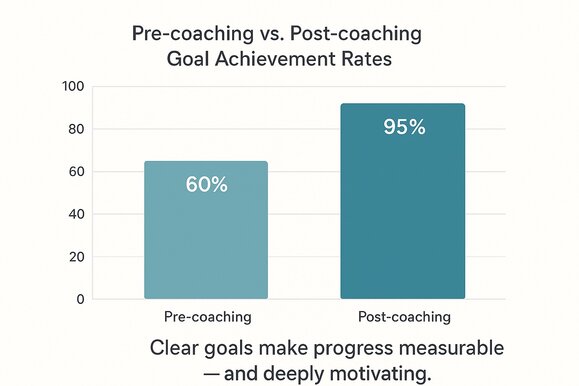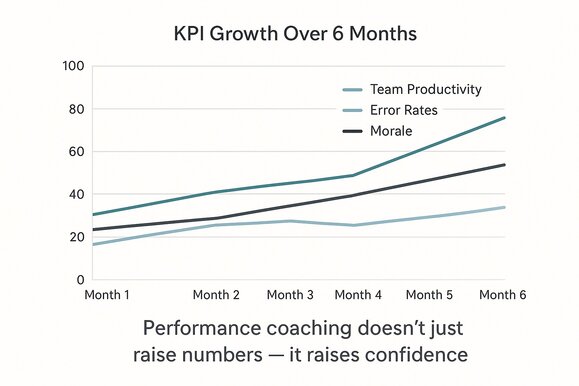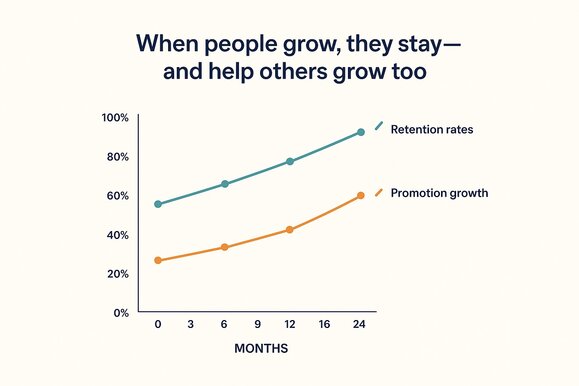Coaching is more than offering advice, it’s a transformative partnership that guides individuals toward growth, clarity, and achievement. But how do you know if coaching truly works? Understanding coaching effectiveness is essential for coaches and clients alike. It’s not just about feeling inspired after a session; it’s about tangible, measurable progress in skills, behaviors, and outcomes.
In this guide, we’ll explore how to measure coaching effectiveness, from key metrics and evaluation methods to best practices and common challenges. Whether you’re a professional coach seeking to validate your approach or someone considering coaching, these insights will help you understand, track, and maximize the impact of every coaching interaction. By the end of this article, you’ll have a practical roadmap to assess coaching success, ensure meaningful results, and enhance personal or organizational growth.
The Hidden Art Behind Measuring Growth
Think of coaching like learning to play the piano. You can count the hours practiced, the songs mastered, the technical precision. But what about the quiet confidence that blooms as your hands find the keys without fear? That’s the invisible kind of progress we often forget to measure. The same is true for coaching effectiveness, the numbers matter, but so does the subtle transformation you feel deep inside.
Recent studies from the International Coaching Federation (ICF) reveal that over 80% of clients report improved self-confidence, while 86% of companies recoup their coaching investment through higher performance and employee retention. These statistics remind us that change is not only emotional; it’s measurable. Still, the real story lies in how these metrics translate into daily life: calmer mornings, more deliberate choices, the rediscovery of energy once thought lost.
When we speak of measuring coaching effectiveness, we’re not just talking about checklists or ROI (return of investment) reports. We’re exploring the intersection of data and humanity where evidence meets experience, and where personal growth turns into visible, lasting change.
Different Lenses on Coaching Effectiveness
Coaching is not one‑size‑fits‑all, and neither is its effectiveness. An executive seeking leadership clarity may measure success differently than a wellness‑focused client aiming to reduce stress or a career seeker striving for promotion. Research supports this diversity in impact. For example, the International Coaching Federation’s 2023 Global Coaching Study illustrates the profession’s global reach and growing credibility: the number of coach practitioners exceeded 100,000 with a 54 % increase since 2019. These findings emphasize that coaching’s influence isn’t just personal, it’s systemic. By understanding coaching through multiple lenses, one begins to see its full power: it’s not just about hitting targets, but about shaping habits, mindsets, and confidence that ripple far beyond the sessions themselves.
Key Metrics for Measuring Coaching Effectiveness
Measuring coaching effectiveness begins with identifying the metrics that truly reflect progress and transformation. Metrics are more than numbers; they are tangible evidence of growth, guiding both coaches and coachees to understand what works and what needs adjustment. Understanding how to measure coaching effectiveness ensures that every session, exercise, and strategy has a purpose and measurable outcome. Choosing the right metrics ensures clarity, accountability, and meaningful results. By measuring coaching effectiveness through these key areas, coaches can provide more targeted, impactful guidance.
Goal Achievement
Setting Clear Objectives
Every impactful coaching journey starts with clear goals. Without direction, even the most motivated coachee can feel lost. Goals should be SMART: Specific, Measurable, Achievable, Relevant, and Time-bound. They give both the coach and the coachee a clear roadmap and a sense of purpose.
For example, a coachee might aim to improve public speaking skills to confidently present at board meetings within three months. Setting this objective allows both parties to track progress in a concrete, measurable way.
- Measuring Progress and Outcomes
Tracking progress requires a blend of quantitative and qualitative measures. Quantitative measures could include project completion rates, sales numbers, or other measurable outputs. Qualitative measures capture shifts in confidence, communication style, or leadership presence.
Example: Sarah, a team leader, set a goal to delegate more effectively. Her coach measured her progress by observing her delegation patterns, gathering feedback from team members, and noting improvements in team productivity. By the end of her coaching period, Sarah had successfully distributed responsibilities, freeing her time for strategic tasks.
Turning Vision Into Milestones
Every coaching journey starts with a dream: more clarity, balance, or performance. But dreams become measurable when translated into specific, time-bound goals. A study by the Institute of Coaching (2023) found that 70 % of coached individuals improved their work performance and 80 % reported stronger self-confidence.
To illustrate:
- Before coaching: A project manager struggled with communication breakdowns, missing project milestones.
- After 8 weeks of coaching: Weekly progress tracking and reflective journaling increased her milestone completion rate from 60% to 95%.
- Her new mantra, “Clarity before urgency,” was born in one of those sessions — a metric in itself for inner change.

A bar chart comparing Pre-coaching vs. Post-coaching Goal Achievement Rates, showing visible improvement (e.g., 60 % → 95 %)
Employee Performance Improvement
Key Performance Indicators (KPIs)
KPIs are essential to evaluate tangible outcomes. These metrics may include productivity levels, error rates, or efficiency improvements. Monitoring these indicators before, during, and after coaching gives a clear view of measurable impact.
Productivity and Skill Development
Coaching is also about developing skills and capabilities. This could mean improving negotiation tactics, enhancing time management, or mastering conflict resolution. Performance improvements indicate that coaching is effectively shaping capabilities.
Example: John, a marketing coordinator, improved campaign engagement by 30% after coaching sessions focusing on creative strategy and project management. The KPI of engagement rate served as a direct measure of coaching effectiveness.
Growth You Can See
Performance improvement isn’t just about productivity; it’s about unlocking human potential. Coaches often track progress through KPIs, feedback loops, and team results.
A logistics team lead used coaching to restructure team meetings and delegate efficiently. Six months later, delivery errors dropped 40 %, and overall satisfaction scores soared.

A line chart showing steady improvement across team productivity, error rates, and morale.
Behavioral and Mindset Changes
Assessing Attitude and Motivation
Behavioral change is a subtle but essential measure of coaching success. It involves observing how coachees respond to challenges, adopt new habits, and approach problems differently.
Feedback from Peers and Managers
External feedback provides perspective beyond self-assessment. Peer reviews and manager observations can highlight improved collaboration, leadership qualities, and adaptability.
Example: David, a software engineer, showed significant improvement in teamwork and proactive problem-solving, as reported by his peers, demonstrating that measuring coaching effectiveness includes observing tangible behavioral change.
The Quiet Revolutions
Behavioral change is often invisible at first — a manager pauses before reacting, an employee finally says “no” to overwork. Yet these micro-moments define true coaching effectiveness.
In one DreamCoachMatch example, a marketing director described herself as “too accommodating.” Her coach worked on boundaries and emotional resilience. After three months, peer feedback noted her as “confident and decisive.”
It wasn’t that she became someone else; she simply became herself with less apology.

A before-and-after word cloud from peer feedback: shifting from words like hesitant, overwhelmed to confident, clear, steady.
Engagement and Satisfaction Levels
Employee Surveys and Feedback
Engagement metrics measure how invested the coachee feels in the process. Surveys, polls, or informal feedback reveal whether coaching sessions are motivating and relevant.
Coaching Relationship Quality
The strength of the coach-coachee relationship is another crucial indicator. Trust, communication, and alignment enhance the effectiveness of interventions.
Example: A project manager reported higher job satisfaction and reduced stress due to weekly coaching sessions, reflecting both engagement and relational quality. This is another way of how to measure coaching effectiveness in practical terms.
Measuring the Pulse
Numbers tell part of the story; emotion tells the rest. Engagement scores and satisfaction surveys are crucial metrics for assessing how employees and clients feel after coaching interventions.
A Gallup workplace study (2024) showed that employees who receive regular coaching are 3.4× more engaged than those who don’t. One tech company used quarterly well-being surveys and saw engagement rise 18 % after implementing leadership coaching.

A pie chart comparing Engaged Employees: Pre-Coaching vs. Post-Coaching.
Retention and Career Growth
Impact on Employee Retention Rates
Effective business coaching can influence retention. Employees who feel supported and see their growth are more likely to remain in the organization, reducing turnover costs.
Promotions and Career Progression
Tracking career advancements, such as promotions or expanded responsibilities, provides long-term indicators of coaching effectiveness.
Example: Sophia achieved a promotion to senior analyst after six months of career coaching, demonstrating skill growth and organizational recognition.
Measuring Longevity
Coaching doesn’t just make people better; it helps them stay. According to Forbes Coaching Council (2024), companies integrating coaching programs reduce voluntary turnover by 25 % on average.
An HR director reported that after introducing internal coaching and regular feedback loops, annual employee retention improved from 68 % to 90 %. Promotions nearly doubled within two years, as people felt seen and supported.

A timeline illustration showing retention rates and promotion growth over 24 months.
Find a coach who helps you turn insight into measurable growth and start your journey toward lasting results today.
Evidence That Metrics Matte
When we explore coaching effectiveness through concrete data, we begin to see how the metrics truly map to change. A 2024 article on measuring the ROI of coaching found that organizations leveraging executive coaching achieved an average return of 5.7 × the cost of coaching. Moreover, an in‑depth 2024 study in the International Journal of Evidence Based Coaching & Mentoring tracked pre‑ and post‑360° feedback in a real‑world intervention and confirmed visible behavioral shifts through multi‑rater surveys. These studies reinforce that setting goals, tracking KPIs, and collecting rich feedback aren’t optional but foundational to measuring coaching effectiveness. When coaches and organizations commit to robust tracking, they’re not just hoping for growth, they’re empowering it.
Methods for Evaluating Coaching Effectiveness
When it comes to measuring coaching effectiveness, there is no single formula that captures the depth of human growth. Success in coaching lives in the subtle shifts: a clearer sense of purpose, a change in tone during meetings, the courage to act differently. Still, to ensure those changes are real and sustainable, both coaches and organizations rely on structured evaluation methods.
Below are the most trusted ways to understand how to measure coaching effectiveness in a way that feels both analytical and human.
- Self-Assessment and Reflection
The most personal method of evaluation begins within. Coaches often guide clients to reflect on their experiences, identify progress, and note what has shifted in their mindset or actions. Self-assessment isn’t just about checking boxes but an honest dialogue with oneself.
Clients might keep reflective journals, complete questionnaires, or rate their satisfaction across specific goals. Over time, these self-evaluations paint a story of transformation, one that no graph can fully capture, but that provides invaluable qualitative insight into coaching effectiveness.
- 360-Degree Feedback
Growth doesn’t happen in isolation. A truly holistic way of measuring coaching effectiveness involves gathering feedback from the people around the coachee — peers, supervisors, and direct reports. This 360-degree approach allows others to confirm visible changes in communication, leadership style, and emotional intelligence.
When feedback aligns with the individual’s self-assessment, the picture becomes clearer: coaching is working. When it doesn’t, it sparks essential discussions about what needs refinement. Either way, it turns subjective growth into shared understanding, bridging self-perception with external validation.
Performance Reviews and Appraisals
Performance reviews provide tangible evidence of progress. Here, organizations look at quantifiable outcomes like sales growth, project delivery, innovation metrics, or leadership scores in order to assess coaching effectiveness.
But beyond the numbers, the best reviews consider how a person shows up at work. Are they more composed under pressure? Do they lead with empathy? A skilled coach helps clients not only meet metrics but also embody their best professional selves. Performance appraisals, when used thoughtfully, connect personal development with organizational success.
Business Outcomes and ROI Analysis
For companies investing in coaching programs, understanding return on investment is vital. Measuring outcomes such as employee retention, engagement, and productivity provides clear evidence of value. A coaching effectiveness study by the International Coaching Federation found that over 86% of organizations reported a positive ROI from coaching programs.
Still, ROI in coaching isn’t purely financial. It’s about ripple effects. The calm manager whose clarity improves team morale, or the executive who makes decisions rooted in purpose rather than panic. When assessing how to measure coaching effectiveness, remember that behind every metric is a human story of restored balance and renewed motivation.
Challenges in Measuring Coaching Effectiveness
If only growth were as easy to quantify as revenue or clicks on a dashboard. But measuring coaching effectiveness isn’t that simple, because coaching works in the quiet layers of change: mindset, confidence, and resilience. Still, understanding the challenges behind these measurements helps both coaches and organizations refine their approach and see the full picture.
Subjectivity and Bias
Human perception plays a huge role in coaching effectiveness. What feels like remarkable progress to one client may seem insignificant to another. Some people measure their success in milestones like landing a promotion, leading a new project, while others define it through subtle shifts: sleeping better, feeling calmer, rediscovering joy at work.
Subjectivity can also enter when managers or teams assess results. Their expectations, personal relationships, or understanding of the coaching process might color their feedback. This doesn’t make the data useless, it simply reminds us that the human element must always be considered when measuring coaching effectiveness.
Example:
A marketing executive once credited her coach for “changing her life” because she finally found the confidence to ask for flexible working hours and spend more time with her family. Yet, her manager saw no measurable change in KPIs and considered the coaching results “neutral.” Both perspectives were true — one captured internal transformation, the other external outcomes. Coaching effectiveness, therefore, must embrace both stories.
Lack of Standardized Metrics
Unlike sales or marketing, there’s no universal formula for how to measure coaching effectiveness. Each organization or individual sets their own benchmarks depending on their goals and context. One coach might track emotional intelligence scores, another might use project delivery timelines or engagement rates.
This variety is both a strength and a challenge. It allows flexibility and personalization but makes comparisons difficult. Establishing a consistent measurement framework — blending both quantitative and qualitative data — can help bring structure to what otherwise feels intangible.
Example:
At a global consulting firm, two divisions hired coaches for leadership development. One tracked success by reduced turnover and employee satisfaction, while the other measured it through faster project delivery. Both teams celebrated success but couldn’t directly compare outcomes because their definitions of success were fundamentally different. This highlighted the need for a shared language in coaching metrics.
Long-Term vs. Short-Term Impact
Coaching’s true impact often reveals itself slowly. A coachee might experience immediate clarity after a few sessions, but the deeper transformation like better decision-making, improved relationships, sustainable habits takes time. Measuring too soon may underestimate the real power of coaching, while waiting too long can make data collection inconsistent.
That’s why experts recommend a layered approach: short-term evaluations for quick insights and long-term tracking for lasting change. Effective coaching effectiveness measurement recognizes that transformation is a marathon, not a sprint.
Example:
A software company once measured its coaching program just three months after implementation. The results seemed modest — minimal changes in productivity and engagement. But when they revisited the data a year later, they discovered a 20% rise in retention and stronger collaboration across departments. The true effect had simply needed time to mature.
Best Practices for Effective Coaching Measurement
When it comes to how to measure coaching effectiveness, the best results come from blending data with intuition: numbers with stories, progress charts with honest conversations. Coaching, after all, is both art and science. To make sure every coaching relationship leads to meaningful growth, professionals use a few timeless best practices.
Using Data-Driven Approaches
While intuition guides great coaches, data confirms their impact. Using measurable tools — goal-tracking dashboards, progress reports, and well-being surveys — brings structure to the process. These instruments help transform subjective experiences into objective patterns that reveal growth over time.
For example, measuring coaching effectiveness through periodic self-assessments and 360-degree reviews gives both client and coach a clear sense of what’s working and what needs refinement. This combination of numbers and narrative creates a balanced, evidence-based understanding of change.
Aligning Coaching Goals with Business Objectives
True coaching effectiveness happens when personal transformation aligns with organizational success. A motivated, balanced employee becomes a stronger contributor to the company’s culture and performance.
DreamCoachMatch coaches often emphasize this harmony. When a client’s goals are clearly linked to team or company objectives like improving communication, building leadership confidence, or reducing burnout, progress becomes measurable in both personal satisfaction and business outcomes. Alignment turns coaching from an isolated activity into a strategic investment.
Continuous Improvement and Adaptation
Coaching is an evolving relationship. Both coach and client learn, adjust, and grow through the process. The best coaches regularly review results, gather feedback, and refine strategies to maintain momentum.
That’s why DreamCoachMatch fosters a vibrant community of professionals who share techniques, insights, and methods for measuring coaching effectiveness. This collective wisdom helps coaches evolve their practice, while clients benefit from the latest, most effective approaches. Continuous adaptation ensures that coaching stays relevant, evidence-based, and deeply human.
Real-Life Coaching Case Studies for Inspiration
Sometimes, the most persuasive evidence of coaching’s power isn’t found in statistics or charts, but in the stories of people whose lives have shifted in tangible, surprising ways. Each of these cases illustrates a different facet of coaching effectiveness, showing that growth is as much about subtle mindset shifts as it is about measurable results.
Engineering Firm – Operational Metrics Boost
A Technical Director at a mid-sized engineering firm was drowning in delays, missed deadlines, and operational chaos. Through focused coaching, they introduced new workflow strategies and accountability systems. Within months, on-time product delivery leapt from 40 % to 93 %, while lead times shrank from 11 weeks to just 7. The transformation wasn’t just numbers on a dashboard — the team’s morale surged, and the office buzzed with a renewed sense of possibility.
Senior Manager – Leadership Clarity
A senior manager in a financial firm felt constantly overstretched, unsure of how to delegate, and stuck in a cycle of frustration. Over 12 hours of coaching across seven months, they clarified their role, set realistic goals, and built confidence in leading their team. The result? They moved from stress and indecision to a calm, assured leadership style, one that colleagues noticed and appreciated.
Healthcare Executive – Burnout Recovery
Hospital leadership is notoriously demanding, and a department head found themselves teetering on the edge of exhaustion, the kind of quiet, creeping burnout that disguises itself as competence. Long hours, relentless pressure, and the emotional weight of patient outcomes had blurred every boundary between work and life. Through burnout coaching, they began to rediscover the art of pause. Their coach introduced brief reflective check-ins at the end of each shift, a delegation plan that empowered junior staff, and daily rituals of grounding — five minutes of breathing before walking into meetings.
Within three months, stress levels dropped by 35 %, and team satisfaction scores rose accordingly. More importantly, the department head felt human again. Their laughter returned to morning rounds, and weekends became sacred time for family, not spreadsheets. This story mirrors hundreds like it, proving that coaching effectiveness isn’t just measured in percentages, but in the restoration of balance.
Measure Your Coaching Success Easily
Best coaches are about transformation that can be felt, seen, and sustained. It’s in the quiet confidence of a leader who listens more deeply, the renewed energy of a professional who finally sets healthy boundaries, or the team that moves with greater clarity and compassion. Measuring that change isn’t about perfection but awareness.
At DreamCoachMatch, coaches combine compassion with precision. They help clients see where growth has happened and where the next opportunity lies. Whether you’re tracking measurable outcomes like productivity and career advancement, or subtle changes like confidence and emotional resilience, the right tools and the right coach make it possible.
When you join DreamCoachMatch as a coach, you become part of a forward-thinking community that values reflection, data, and human connection equally. Together, you learn how to measure coaching effectiveness not as a cold process but as an art of mindful accountability.
Find a coach who aligns with your vision, understands your challenges, and helps you define success on your terms. Or, if you’re a coach yourself, become part of the platform that celebrates measurable, meaningful growth.
Join DreamCoachMatch today and start building a practice where every breakthrough, no matter how small, becomes visible, celebrated, and real.






